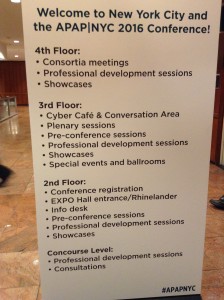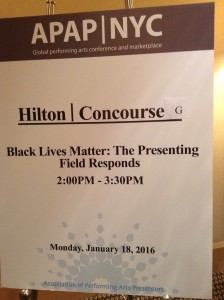By Carol Cooper
Over the Martin Luther King holiday weekend The Association of Performing Arts Presenters (better known as APAP) invited the MCSM RamPage to report on their national convention for the second year in a row.
APAP is a 59 year old political organization that uplifts and educates the American public through the performing arts. The unifying theme of this annual gathering at the N.Y. Hilton Hotel was “Makers,” in honor of all those practitioners of art and science who bring dreams into reality.
High school and college students are especially important to APAP because they are tomorrow’s creative innovators and decision makers. So if you wonder why an urban STEM school like Manhattan Center would be of interest to a performing arts networking group, be aware that the many non-profit and educational companies that comprise APAP’s membership may soon be wanting to hire you.
In addition to creating entertainment, these companies are also striving to implement carbon neutral strategies and sustainable technologies in their buildings, classrooms, and performance spaces. They need socially conscious engineers, scientists, architects and computer techs to help them reach their many goals. On the artistic side of the equation, many musicians, poets/rappers, dancers and theater producers are now creating shows with scientific, environmental, and sustainability themes.
This year I met many individual men and women who make their living (and make a difference) by combining art, education and community activism. Carlton Turner is the Executive Director of “Alternate Roots” in Atlanta, Georgia. It’s a non-profit organization steeped in hip-hop and black culture whose team now supports politically-aware arts initiatives in 14 surrounding states.
A graduate of APAP’s brand new Leadership Fellows Program, Turner now hopes to end “the generational isolation between old heads and younger arts workers.” One such “old head” is Mr. Sparkie Martin, a veteran event producer, promoter, manager and travel agent who runs at least three different companies that support performing arts. He also mentors aspiring promoters through his Africa Umoja [www.umojatheshow.com] and B.B.King’s Blues Club projects.
Last year in Detroit APAP helped to fund a successful multimedia performance piece called “Complex Movements: Beware the Dandelions” for Lane Czaplinski’s “On the Boards” series. It featured the rapper Invincible reciting a spoken meditation on complex systems and science to which a local artist collective contributed sets and sound. At the show’s end, Seattle based environmental activists were on hand to engage the audience in post-performance dialogues!
It’s important to remember that both public and private grant monies paid for this theatre project. Funding artistic productions is part of what various U.S. government agencies do, and whatever they choose to support can be controversial depending on what kinds of politicians are running your city, state or nation.
As we come to the end of Obama’s historic presidency, activists like APAP are aware that the cultural diversity they have always supported might be endangered if more conservative, xenophobic leadership wins the upcoming elections. So part of APAP’s yearly conference always celebrates the rewards of diversity in artistic expression. No matter what color, what religion, gender, age, nationality or sexual persuasion you are, your ideas and creativity matter.
Because APAP serves *all* performing artists, from classical chamber orchestras to Chinese Opera, from hip-hop poetry slams to EDM deejays, there were panels discussing every possible aspect of how to produce and improve such presentations.
There were workshops on how to promote live performances to tech-savvy teens. How to improve student involvement in college art center events. How women of color can attain more professional opportunities as community art administrators; and how to surmount bigotry when promoting LBGTQ programming. Many of these conversations were led by undergraduates interning at various national theaters.
Student participation in APAP is massive with so many colleges hosting both arts centers and entertainment business degree programs on campus. What amazed me most was how many of these young collegiate entrepreneurs were willing and able to master multiple skill sets. I encountered entertainment law students who were also singer/songwriters; viola players who ran digital marketing companies; and math majors who led their own rock bands on the side.
This trend of increasing convergence between art, business administration, and the sciences was best explained to me by Willis Caldwell, a graduate assistant at the two and a half year old Virginia Tech Center for the Arts. Virginia Tech began brainstorming about a more integrated arts and science curriculum as early as 2000.
Now this major university offers a number of interdisciplinary initiatives that recognize (in the wake of the tragic 2007 Virginia Tech campus shootings) that the solution to better life on this planet may come from integrating knowledge from art theory, engineering theory, design theory, with the new sciences.
[If you are curious about any of these Virginia Tech programs, google their Institute for Creativity, Arts and Technology at: www. icat.vt.edu]
***
APAP isn’t only talk. It facilitated about 1000 live performance showcases at various city venues during this conference, including Webster Hall’s globalFEST. Unfortunately because of the drinking age restrictions and other bureaucratic barriers, high school kids weren’t invited to see them. Nevertheless, high school students benefit directly from the work APAP members do each summer, when all the free festivals hosted at city parks and beaches bring new music, theater and dance projects out to the public.
For more info about next year’s free World Music pre-conference and to sample music from Sunday night’s 2016 globalFEST concert go to rockpaperscissors.com.
[To learn more about APAP go to: apapnyc.org]


